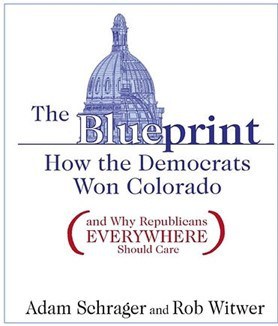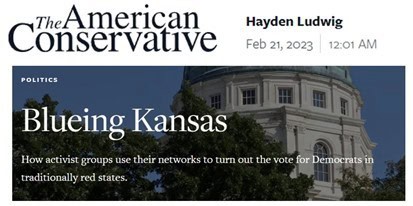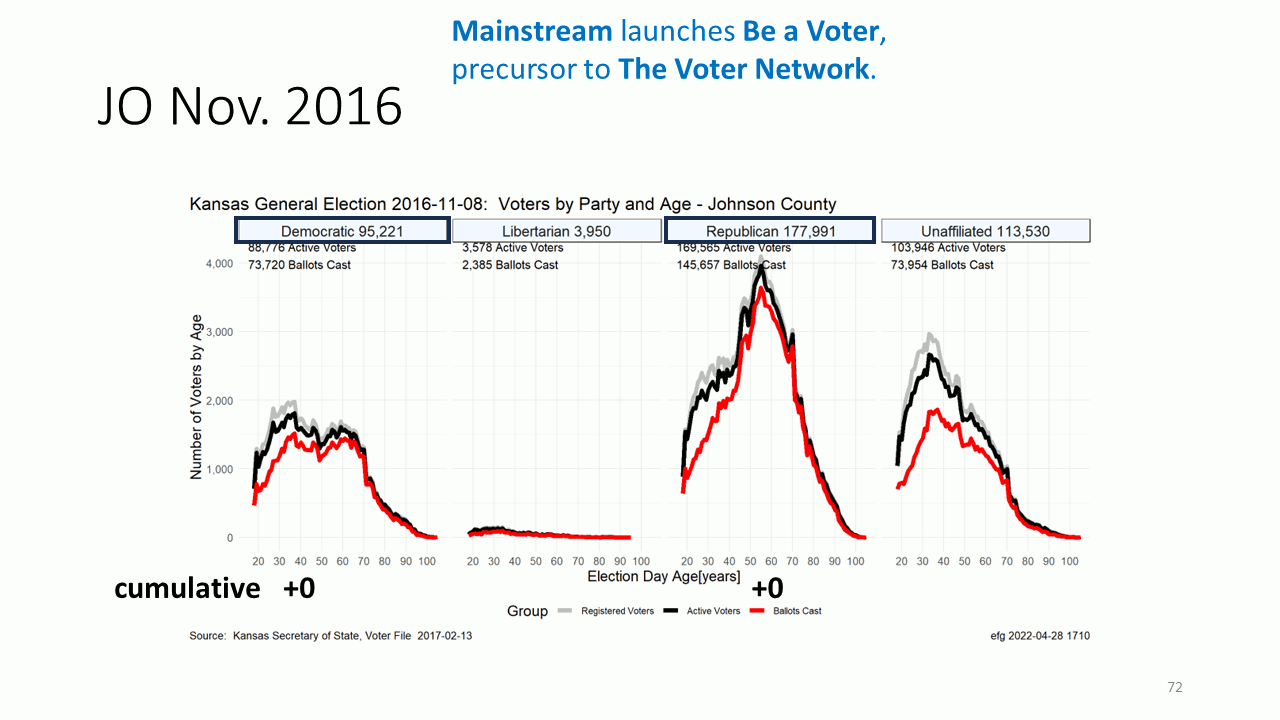Note: This is the final article in a four-part series on “Integrated Voter Engagement” in Kansas by Earl F. Glynn. The Sentinel is reprinting the series with Glynn’s permission.
This article reveals the impact of IVE on Kansas, and especially the “blueing” of Johnson County.
Part 1 reviewed the history of IVE and how it started in Kansas. Kansas healthcare foundations spent big on Integrated Voter Engagement (IVE) to push for “health equity.”
Part 2 looked at the healthcare foundations funding Integrated Voter Engagement in Kansas. Four healthcare nonprofits were formed in Wichita and the Kansas City area from the sale of nonprofit hospital systems to a for-profit company. Three of these nonprofit foundations spent nearly $9 million on IVE in Kansas.
Part 3 highlighted the Kansas nonprofits receiving funding to engage in IVE. About 10 nonprofits received two rounds of funding from the healthcare foundations to fund IVE from 2017 through early 2025. Other nonprofits were funded as part of “capacity” building to provide services needed in the election process.
Colorado Blueprint in Kansas?
A “gang of four” multi-millionaires formed the Colorado Democracy Alliance in 2004 and started an “integrated voter engagement” experiment to build long-term progressive infrastructure in that state.

By 2010, Colorado had turned mostly blue.
By 2018, Colorado Democrats won the offices of governor, secretary of state, attorney general, and the majority of the state Senate in 2018, “cementing Colorado’s 15-year shift from reliably purple to solidly blue.”
Is Kansas following the path of Colorado?
Blueing Kansas: all Integrated Voter Engagement Spokes Covered
One measure of how Integrated Voter Engagement is evolving in Kansas is to consider how many of the IVE “spokes” are addressed by nonprofits. What “capacity building” is needed to provide all the functionality in the IVE model?

In 2024, Kansas progressive nonprofits provided most of the functionality in the IVE “spoke” model. Most of these nonprofits received IVE funding from the Wichita-based Kansas Health Foundation, as well as two KC-area healthcare foundations.
The model above shows there are one or more Kansas progressive nonprofits covering all the integrated voter engagement spokes. Little additional “capacity building,” if any, is needed to complete all aspects of IVE in Kansas.
A “Blueing Kansas” article last year gave an overview of what was happening in Kansas due to IVE. This series of four articles provided many additional details.

A 2023 article by Hayden Ludwig in The American Conservative outlined how IVE was affecting Kansas.
Now they are turning their sights on Kansas, a red state they hope to flip blue …
At the scheme’s center is the Kansas Health Foundation, a “social justice” advocacy group masquerading as a local issues charity. …
the foundation launched its Integrated Voter Engagement (IVE) Initiative with funding for get out the vote groups “to increase civic engagement among populations who…do not currently participate in the democratic process.” …
As we’ve documented, the Funders Committee brags that its Integrated Voter Engagement model is one of “the most effective ways to increase voter turnout” and helped turn Colorado from a red to a purple state in the early 2000s. …
In Kansas, that means targeting “health equity issue areas”—a lefty term loosely defined as access to “quality schools and housing,” “good jobs and healthy food,” and the “safety of our neighborhoods”—but in reality refers to targeting likely Democratic voters, many of whom are not on the voter rolls.
IVE can be credited in 2022 with the re-election of Democrat Gov. Laura Kelly, who won by only 22,258 votes. But IVE was ineffective in preventing the election of Republicans to all other statewide offices.
Election results from Johnson County indicate IVE may have turned the county blue, but not so much in the rest of the state.
The blueing of Johnson County
Progressive “capacities”
Two progressive “capacities” are likely to blame for turning JoCo blue:
- The Voter Network’s Voter-to-Voter and KSBallot.org projects. In particular, the Voter-to-Voter “peer pressure with a purpose” has contacted 34,000 voters in 92 counties using about 2,500 “ambassadors” to recruit and later shepherd voters to the polls. The Voter Network’s old name was “Mainstream Coalition” and has been active in progressive politics in Johnson County for three decades. Their ambassadors are likely predominately in Johnson County.
- Blueprint Kansas doing business as KSVotes.org. This organization is the “nonprofit in the middle” between voters and election offices. Dozens of progressive organizations, including The Voter Network, channel voters to KSVotes.org to register or request advance ballots. Blueprint Kansas claims to have registered nearly 86,000 voters and have sent over 105,000 advance ballots through their system. It’s likely a large portion of their web traffic is from Johnson County and they now shepherd nearly 100,000 voters to the polls.
These capacities focus on the mechanics of getting ballots returned, and little on the debate of ideas.
Republican Losses in JoCo in 2022
In 2022, these Republicans lost in Johnson County but won statewide:
- US Senator Jerry Moran lost JoCo by 3,484 votes.
- Kansas Secretary of State Scott Schwab lost his home county by 6581 votes.
- Kansas Attorney General Kris Kobach lost JoCo by 55,291 votes.
Two Republicans lost elections and Johnson County by wide margins:
- Gubernatorial candidate Derek Schmidt lost JoCo by 52,942 votes (and statewide by 22,258 votes).
- US Congressional candidate Amanda Adkins lost JoCo by 41,299 votes (and KS-03 district by 36,688 votes).
The table below shows that from 2016 through 2022, Democrats in JoCo gained an advantage over Republicans by about 41,214 registered voters. This was almost exactly the margin Amanda Adkins lost by in JoCo in 2022.

Registered voters in Johnson County by party show a Democratic advantage of 41,214 voters from 2016 to 2022. The “delta” columns show the cumulative gains since 2016. The “D Advantage” column shows the cumulative Democratic advantage compared to Republican gains.
During this same 2016 to 2022 period, the whole state of Kansas showed a Democratic voter registration advantage of 6717 voters, which is a modest gain given the $9 million in IVE spending.
That works out to about $1300 per new registered voter. How has that spending helped healthcare or health “equity” in Kansas?

JoCo turnout curves
The curves below for November elections in even-numbered years show counts for each year of age from 18 to 105 for:
- registered voters (gray curve),
- “active” voters (black curve), and
- ballots cast in the election (red “turnout” curve).
Here, the focus is only on the registered voters (gray curves), but the other curves tell important stories.
The animated GIF below reveals the cumulative voter registration differences from 2016 for Democrats and Republicans, along with the “Democratic Advantage” shown at the bottom. The numbers from the table above also appear in the graphic below.
The plots for each of the years 2016, 2018, 2020, and 2022 appear for about two seconds. From 2016 to 2022, Democrats had an advantage of 41,214 in Johnson County.
A yearly summary of increasing IVE activities is shown at the top right, which appears to explain the shifts in Johnson County, especially for Democrats aged 18 to 35.

The analysis of the IVE impact by county for all 105 counties has not been completed.
Notes
- The area between the gray curve (registered voters) and the black curve (active voters), represents the number of “inactive” voters. At present there are few checks and balances in place that these voters with unknown addresses are voting in the correct “district” elections. Provisional ballots with address verification is needed to ensure “inactive” voters are casting ballots in the correct “district” elections.
- The area between the black curve (active voters) and the red curve (voters casting ballot) represents the number of “low propensity” voters that are not showing up to vote. In particular, not the large number of “low propensity” unaffiliated voters in most elections.
- The area between the red curve (voters casting ballots) and the X-axis represents the total number of voters in an election.
2016-2022 Registered Voter Party Shifts in Other Counties
While Democrats gained an advantage of over 41,000 votes in 2016-2022 in Johnson County, political shifts in other counties likely caused by IVE were much smaller.
Sedgwick and Shawnee counties showed modest shifts to Republicans.


Democratic counties, Wyandotte and Douglas, shifted to be more “blue.” The larger shift in Douglas County over slightly larger Wyandotte County is a bit surprising but is explained by college voters at KU.


Dark money and other nonprofits impacting Johnson County
“Dark Money” in JoCo/KS-03
|
Nonprofit money in JoCo/KS-03
|
|




